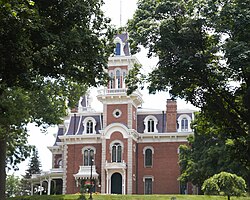First floor
The first floor of Terrace Hill is a formal area. The rooms on the first floor were used often for reception of important guests, a tradition which continues.
The vestibule is the entry area to the mansion. Formerly, a servant would greet guests in the vestibule. They would enter through two sets of doors there that weigh more than 200 pounds (90 kg) each.
From there, guests would be taken to the reception room. Guests would wait while their presence was announced to the owners, and the host or hostess would greet them in that room.
Across the hall is the drawing room. At one time it was used for weddings and funerals of the home's residents. Now the room is used for important events – which include entertaining of foreign dignitaries. The room also features a 7.5 foot (2.3 m) crystal chandelier, and handcarved, laminated, rosewood Belter furniture.
The music room was previously an entertainment room. Young women would usually play music in this room. The room features a Steinway "Music Room Grand" from 1869 – the same year the house was completed.
The dining room was used for formal dinners by the previous owners of the home. Today the dining room continues to be used for state dinners and receptions. Food served in the dining room is prepared in the kitchen in the basement.
The library was another important room on the first floor. It served originally as the gathering place for the men of the home, and as a storage place for knowledge. The room contains several interesting items, which include F. M. Hubbell's leather chair. Because he was just over 5 feet (1.5 m) tall, the chair sits close to the floor to accommodate him. There is also a portable gentleman's "desk", and a partners' table, where two people could work at once.
The sitting room was the family room during earlier times.
All of these rooms are connected by the main hall. The ceilings in the hall are 14.5 feet (4.4 m) tall. The main hall has carpets by Wilton. There are also a number of interesting portraits.
Outside there is a large porch that overlooks the downtown area. It is still used occasionally for parties.
Second floor
At the end of the main hall on the first floor, there is a grand staircase that leads up to the second floor, with a landing in between. At the landing between the first and second floors, there is a stained glass window. The window is often described as "garden in glass" and measures 9 by 13 feet (3 by 4 m). This window colors the landing and part of the staircase with colorful light. The window was added by F. M. Hubbell between 1884 and 1890.
After the landing, the staircase divides into two approaches to the second floor. Originally the second floor served as the bedrooms for most of the family. Now, the formal office of the governor is located on the second floor (their working office is located at the Capitol).
The First Gentleman's office is also located on the second floor. Their office is not normally part of tours because the office is used as a working office for writing speeches, scheduling appearances, and planning special events.



